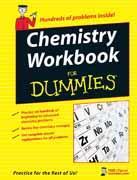Peter J. Mikulecky, Katherine Brutlag, Michelle Rose Gilman and Brian Peterson
Hoboken, New Jersey: Wiley 2008 | Pp344 | £13.99 | ISBN 978 047 025 152 2
Reviewed by Ann Lewis-Kell

This useful book will be of benefit to post-16 students who want to practise the different type of chemical calculations met at AS-level and beyond. The content is divided into five parts (22 chapters) and these are clearly explained in the introductory pages, eg part one - Getting cosy with numbers, atoms and elements - emphasises how chemists must handle numbers with care and according to certain rules.
Icons in the margins guide students through the most important aspects of that chapter, eg the 'remember' icon highlights what they must know while the 'warning' icon tells them to pay attention or they will struggle to understand. There are numerous worked examples and the detailed solutions provided would be useful to keen independent learners who want to improve their understanding of a topic. There are plenty of additional exercises at the end of each chapter and, more importantly, rather than just giving numerical answers, the authors provide a brief outline of how the solutions are derived.
The chapters cover many areas that form part of the current AS/A2 chemistry specifications. Key examples include the mole and stoichiometry, thermochemistry, acid-base equilibrium and electrochemistry. The sixth chapter on naming compounds is well structured and essential reading for keen GCSE students who want to perform at a high level in inorganic chemistry. Chapter seven, Managing the mighty mole, provides a good feel of how big the Avogadro constant is by stating that it is larger than the number of stars in the sky or the number of fish in the sea.
This is not the type of book that you would read from cover to cover but if your students are willing to read all the text then they will come across many little gems that will help them to remember some key facts, eg the phrase 'red cat' is a useful way to remember that reduction occurs at the cathode. The section on balancing redox equations is excellent and as good as anything that I have seen.
Since the book is geared toward the US market there is nothing on atom economy, the unit of volume is litre rather than dm3 and names such as formaldehyde and acetic acid are used rather than methanal and ethanoic acid.
Printed on poor quality, absorbent paper, heavy use of a highlighter pen is to be discouraged because this makes the reading of the page overleaf quite difficult. However, this book is reasonable value for money and should be a compulsory purchase for the school or college library.






No comments yet